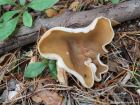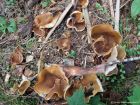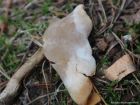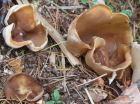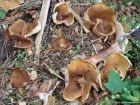Fruiting body sessile and cup-shaped, often with an irregular outline that eventually spreads. The margin starts incurved, becomes upright, and finally levels out or recurves, appearing crenate to lacerate. The hymenium is concave, ranging from even to wrinkled or furrowed, and is glabrous with a light brown to chestnut-brown colour, sometimes showing a reddish-brown tint. The exterior surface is white to ash-grey and finely tomentose to furfuraceous. Spore print white to pale cream.
Microscopic Features: Spores 11-16 x 6-10 µm, smooth, elliptical, without oil droplets.
Peziza repanda on the MushroomExpert.Com Web site.
Many mushrooms are poisonous, and some can be lethally toxic. Distinguishing between edible and poisonous mushrooms can be very challenging. Therefore, we strongly advise against consuming wild mushrooms. This website does not contain any information about the edibility or toxicity of mushrooms.
Although efforts have been made to ensure accuracy on this website, the information may contain errors and omissions. Therefore, all content provided is for educational and informational purposes only and should not be relied upon or used as a basis for consuming any plants or mushrooms.
External links are provided for reference only. We do not endorse or take responsibility for the content, advice, or products found on these sites or in any advertisements shown on this website.
